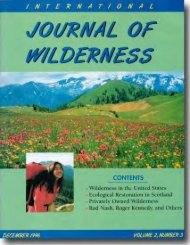Download full PDF - International Journal of Wilderness
Download full PDF - International Journal of Wilderness
Download full PDF - International Journal of Wilderness
Create successful ePaper yourself
Turn your PDF publications into a flip-book with our unique Google optimized e-Paper software.
Inholdings<br />
within <strong>Wilderness</strong><br />
Legal Foundations, Problems, and Solutions<br />
For many people, the wilderness ideal is a vast and<br />
contiguous tract <strong>of</strong> unspoiled wild land. However,<br />
unknown to many is the fact that well over one<br />
million acres (404,700 ha.) and thousands <strong>of</strong> parcels <strong>of</strong><br />
private or state-owned lands may be contained within U.S.<br />
designated wildernesses. These lands, termed wilderness<br />
inholdings, present challenges to wilderness advocates that<br />
require creative solutions and deliberate action due to serious<br />
concern about motorized access to inholdings, land<br />
speculation and threatened development, use <strong>of</strong> inholdings<br />
that are incompatible with wilderness, legal ambiguities <strong>of</strong><br />
ownership rights, and multiple legal guidelines for wilderness<br />
managers.<br />
In the western United States, land inholdings in wilderness<br />
are largely a result <strong>of</strong> five legislative acts: The 1872<br />
Mining Law (17 Stat. 91), the 1862 Homestead Act (12<br />
Stat. 392), the 1864 and 1870 Land Grant Acts (12 Stat.<br />
503 and 26 Stat. 417), and the Alaska Native Claims and<br />
Settlement Act (ANCSA) (P.L. 92-203). Under the first four<br />
Acts, public lands were distributed to the private sector and<br />
states to advance westward expansion and development <strong>of</strong><br />
the land; ANCSA distributed public lands to Alaskan Natives<br />
as a land settlement. Many inholdings in wilderness<br />
areas are quite large. Under the 1872 Mining Law, parcels<br />
were claimed in units <strong>of</strong> 20 acres (8 ha.), and 160 acres (64<br />
ha.) were turned over to individuals under the Homestead<br />
Act. While these four acts distributed land to private individuals,<br />
the Land Grant Acts distributed land to States in<br />
640-acre (259 ha.) parcels. ANCSA awarded a total land grant<br />
<strong>of</strong> 44 million acres (18 million ha.) to Alaskan Natives for<br />
renouncing all claims to the rest <strong>of</strong> the state (Zaslowsky 1986).<br />
The result on the landscape was a patchwork <strong>of</strong> private and<br />
state-owned land scattered across public lands.<br />
BY RANDY TANNER<br />
STEWARDSHIP<br />
In contrast with the western United<br />
States much <strong>of</strong> the land in the eastern<br />
part <strong>of</strong> the country was privately<br />
owned before public lands were established<br />
by the U.S. government. When<br />
the federal government decided to establish<br />
public lands in the eastern<br />
United States, it was difficult to do so<br />
without some private or state-owned<br />
lands being contained within them.<br />
Thus, wildernesses throughout the<br />
United States were <strong>of</strong>ten established<br />
containing inholdings: it would have<br />
severely limited the National <strong>Wilderness</strong> Preservation System<br />
(NWPS) to have excluded such areas. Table 1 lists the<br />
acres <strong>of</strong> private and state land inholdings contained within<br />
designated wildernesses administered by the U.S. Forest<br />
Service (USFS), Bureau <strong>of</strong> Land Management (BLM), and<br />
National Park Service (NPS). Data on the acreage <strong>of</strong><br />
inholdings within U.S. Fish and Wildlife Service (USFWS)<br />
wilderness areas is not available.<br />
Article author Randy Tanner.<br />
Problems Associated with<br />
<strong>Wilderness</strong> Inholdings<br />
Inholdings present wilderness advocates and federal<br />
agencies with a number <strong>of</strong> problems, and these can be<br />
summarized into five main categories: motorized access<br />
across wilderness to inholdings, land speculation and threatened<br />
development <strong>of</strong> inholdings, use <strong>of</strong> inholdings that are<br />
incompatible with wilderness, legal ambiguities related to<br />
the property rights <strong>of</strong> inholding landowners, and multiple<br />
legal guidelines for wilderness managers.<br />
<strong>International</strong> <strong>Journal</strong> <strong>of</strong> <strong>Wilderness</strong> DECEMBER 2002 • VOLUME 8, NUMBER 3 9










